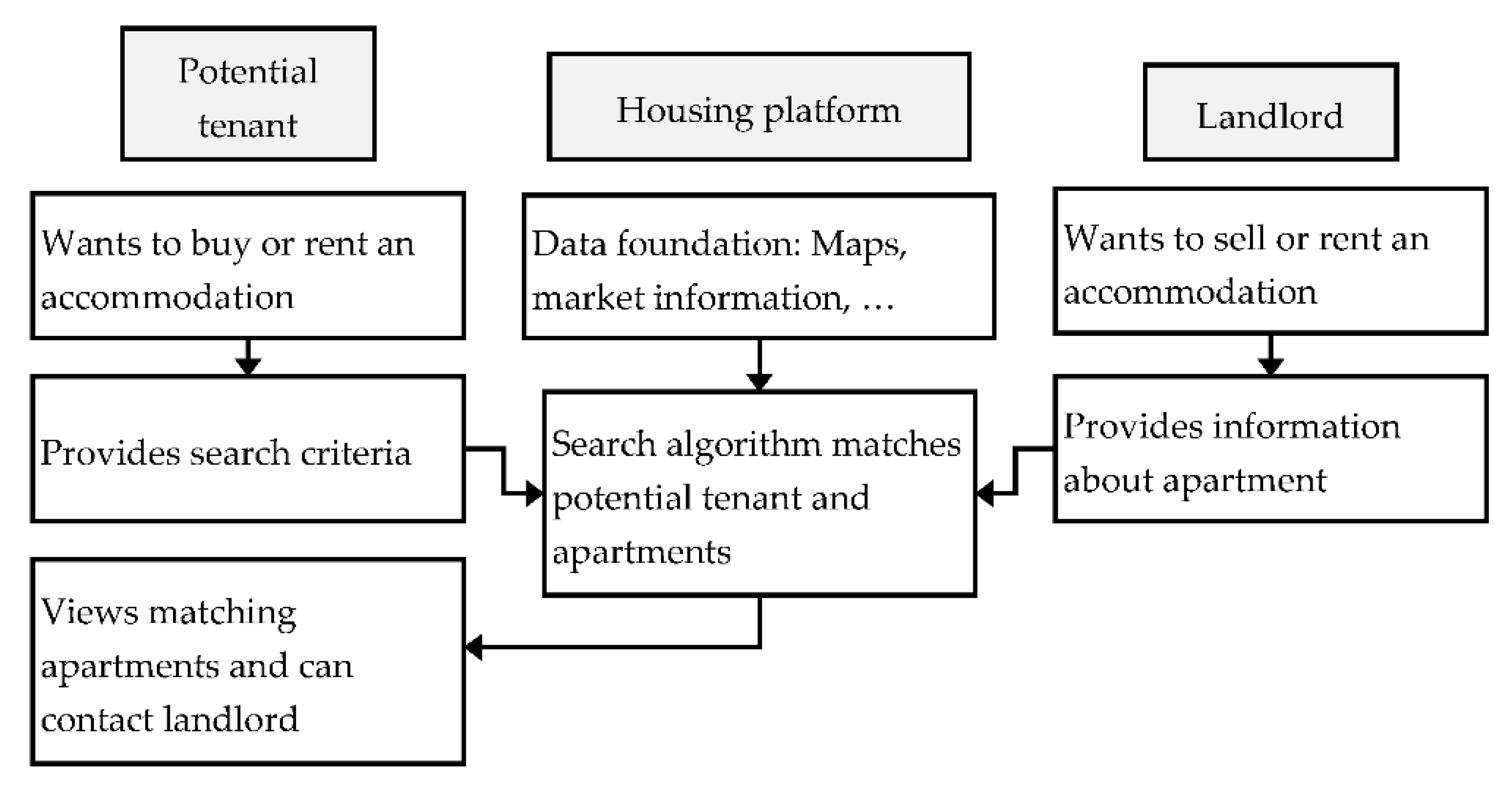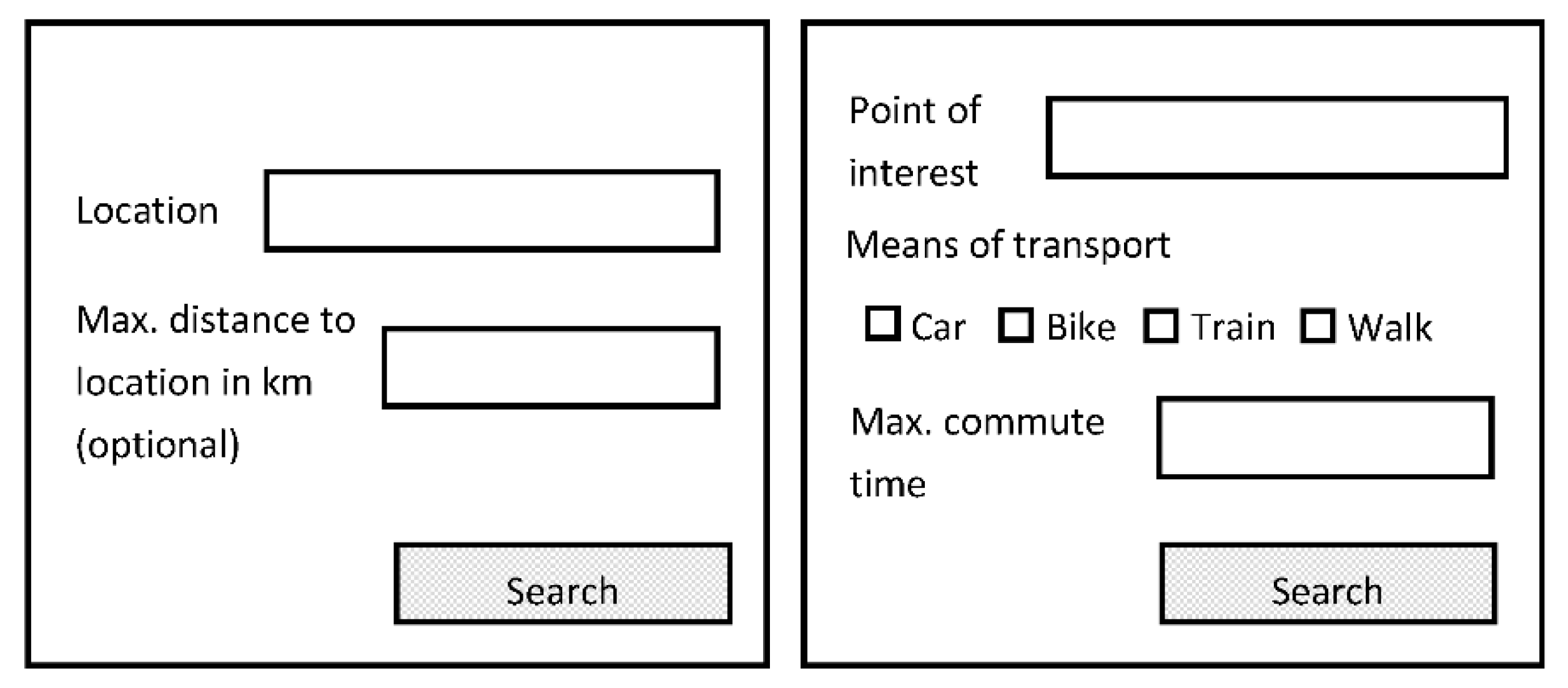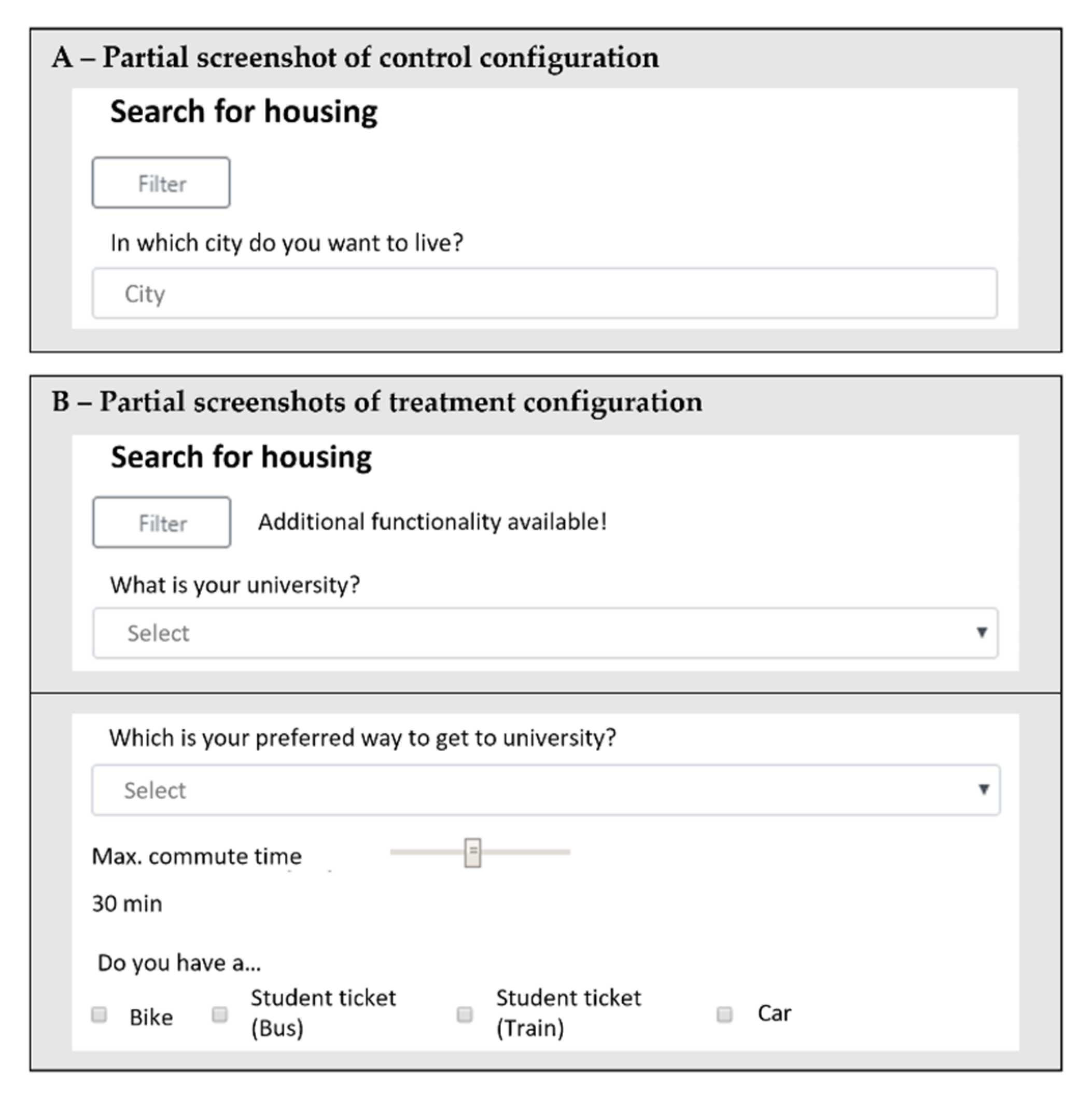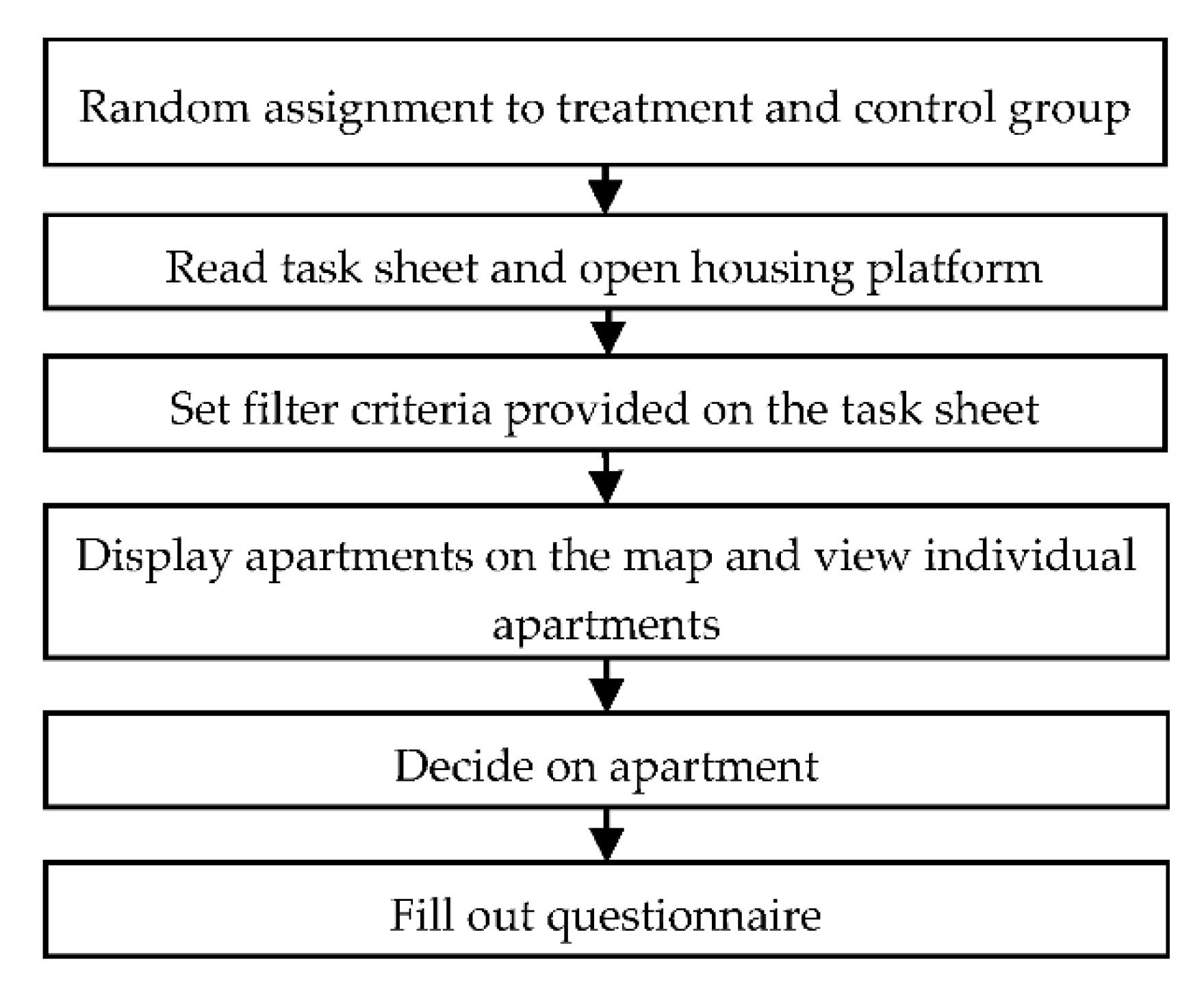Mobility Need-Adaptive Housing Platforms: The Benefit of a Commute Time Search Feature
Abstract
1. Introduction
2. Research Background
2.1. Research of Digital Housing Platforms

2.2. Design of Existing Housing Platforms
3. Theoretical Lens and Hypotheses Derivation
3.1. Cognitive Fit of Task and Problem Representation
3.2. Technology Acceptance
4. Research Design
4.1. Control and Treatment Configuration
4.2. Data Collection Procedure
4.3. Measures
5. Results
6. Discussion
6.1. Theoretical Implications
6.2. Practical Implications
6.3. Limitations and Future Research
7. Conclusions
Author Contributions
Funding
Institutional Review Board Statement
Informed Consent Statement
Data Availability Statement
Acknowledgments
Conflicts of Interest
References
- Inchauste, G.; Karver, J.; Kim, Y.S.; Jelil, M.A. Living and Leaving: Housing, Mobility and Welfare in the European Union; World Bank: Washington, DC, USA, 2018. [Google Scholar]
- Van Doorn, L.; Arnold, A.; Rapoport, E. In the Age of Cities: The Impact of Urbanisation on House Prices and Affordability. In Hot Property; Nijskens, R., Lohuis, M., Hilbers, P., Heeringa, W., Eds.; Springer International Publishing: Cham, Switzerland, 2019; pp. 3–13. ISBN 978-3-030-11673-6. [Google Scholar]
- Saiz, A. The Geographic Determinants of Housing Supply. Q. J. Econ. 2010, 125, 1253–1296. [Google Scholar] [CrossRef]
- Glaeser, E.; Gyourko, J. The Economic Implications of Housing Supply. J. Econ. Perspect. 2018, 32, 3–30. [Google Scholar] [CrossRef]
- Ahrens, A.; Lyons, S. Do rising rents lead to longer commutes? A gravity model of commuting flows in Ireland. Urban Stud. 2021, 58, 264–279. [Google Scholar] [CrossRef]
- Stutzer, A.; Frey, B.S. Stress that Doesn’t Pay: The Commuting Paradox. Scand. J. Econ. 2008, 110, 339–366. [Google Scholar] [CrossRef]
- Creutzig, F.; Jochem, P.; Edelenbosch, O.Y.; Mattauch, L.; van Vuuren, D.P.; McCollum, D.; Minx, J. Transport: A roadblock to climate change mitigation? Science 2015, 350, 911–912. [Google Scholar] [CrossRef] [PubMed]
- Wang, H.; Zeng, W. Revealing urban carbon dioxide (CO2) Emission characteristics and influencing mechanisms from the perspective of commuting. Sustainability 2019, 11, 385. [Google Scholar] [CrossRef]
- Balbontin, C.; Ortúzar, J.D.D.; Swait, J.D. A joint best-worst scaling and stated choice model considering observed and unobserved heterogeneity: An application to residential location choice. J. Choice Model. 2015, 16, 1–14. [Google Scholar] [CrossRef]
- Krysan, M. Does race matter in the search for housing? An exploratory study of search strategies, experiences, and locations. Soc. Sci. Res. 2008, 37, 581–603. [Google Scholar] [CrossRef] [PubMed]
- Dunning, R.J.; Grayson, A. Homebuyers and the representation of spatial markets by information providers. Int. J. Hous. Mark. Anal. 2014, 7, 292–306. [Google Scholar] [CrossRef]
- Kroft, K.; Pope, D.G. Does Online Search Crowd Out Traditional Search and Improve Matching Efficiency? Evidence from Craigslist. J. Labor Econ. 2014, 32, 259–303. [Google Scholar] [CrossRef]
- Immowelt, A.G. Available online: https://www.immowelt.de/ (accessed on 20 February 2021).
- RentPath, LLC. Available online: https://www.rentals.com/ (accessed on 20 February 2021).
- CoStar Group, Inc. How to Find an Apartment with a Great Commute. Available online: https://www.apartments.com/blog/how-to-find-an-apartment-with-a-great-commute (accessed on 20 February 2021).
- Homesnap, Inc. Introducing: Search by Commute Time. Available online: https://blog.homesnap.com/introducing-search-commute-home-search/ (accessed on 23 February 2021).
- RentPath, L. Factoring a New Commute into Your Apartment Search. Available online: https://www.rent.com/blog/new-commute-apartment-search/ (accessed on 20 February 2021).
- Borchert, B. Die neue Immobilienscout24-Fahrzeitsuche: Einfach & Innovativ—Eine Kurze Erklärung. Available online: http://web.archive.org/web/20200927074103/https://blog.immobilienscout24.de/die-fahrzeitsuche-bei-immobilienscout-24-kurz-erklaert/ (accessed on 20 February 2021).
- Rashidi, T.H. Dynamic housing search model incorporating income changes, housing prices, and life-cycle events. J. Urban Plan. Dev. 2015, 141, 4014041. [Google Scholar] [CrossRef]
- Rashidi, T.H.; Auld, J.; Mohammadian, A.K. A behavioral housing search model: Two-stage hazard-based and multinomial logit approach to choice-set formation and location selection. Transp. Res. Part A: Policy Pract. 2012, 46, 1097–1107. [Google Scholar] [CrossRef]
- Vessey, I. Cognitive Fit: A Theory-Based Analysis of the Graphs Versus Tables Literature. Decis. Sci. 1991, 22, 219–240. [Google Scholar] [CrossRef]
- Davis, F.D.; Bagozzi, R.P.; Warshaw, P.R. User Acceptance of Computer Technology: A Comparison of Two Theoretical Models. Manag. Sci. 1989, 35, 982–1003. [Google Scholar] [CrossRef]
- Davis, F.D. Perceived Usefulness, Perceived Ease of Use, and User Acceptance of Information Technology. MIS Q. 1989, 13, 319–340. [Google Scholar] [CrossRef]
- Bina, M.; Warburg, V.; Kockelman, K.M. Location Choice vis-à-vis Transportation. Transp. Res. Rec. 2006, 1977, 93–102. [Google Scholar] [CrossRef]
- Plaut, P.O. The intra-household choices regarding commuting and housing. Transp. Res. Part A: Policy Pract. 2006, 40, 561–571. [Google Scholar] [CrossRef]
- Ye, R.; de Vos, J.; Ma, L. Analysing the association of dissonance between actual and ideal commute time and commute satisfaction. Transp. Res. Part A: Policy Pract. 2020, 132, 47–60. [Google Scholar] [CrossRef]
- Kobus, M.B.; van Ommeren, J.N.; Rietveld, P. Student commute time, university presence and academic achievement. Reg. Sci. Urban Econ. 2015, 52, 129–140. [Google Scholar] [CrossRef]
- Kroesen, M. Assessing Mediators in the Relationship between Commute Time and Subjective Well-Being. Transp. Res. Rec. 2014, 2452, 114–123. [Google Scholar] [CrossRef]
- Lorenz, O. Does commuting matter to subjective well-being? J. Transp. Geogr. 2018, 66, 180–199. [Google Scholar] [CrossRef]
- Ta, N.; Chai, Y.; Zhang, Y.; Sun, D. Understanding job-housing relationship and commuting pattern in Chinese cities: Past, present and future. Transp. Res. Part D: Transp. Environ. 2017, 52, 562–573. [Google Scholar] [CrossRef]
- Rahman, M.H.; Ashik, F.R. Is neighborhood level Jobs-Housing Balance associated with travel behavior of commuters? A case study on Dhaka City, Bangladesh. GeoScape 2020, 14, 122–133. [Google Scholar] [CrossRef]
- Immobilien Scout GmbH. Available online: https://www.immobilienscout24.de/ (accessed on 20 February 2021).
- Yuan, X.; Lee, J.-H.; Kim, S.-J.; Kim, Y.-H. Toward a user-oriented recommendation system for real estate websites. Inf. Syst. 2013, 38, 231–243. [Google Scholar] [CrossRef]
- Fradkin, A. Search, Matching, and the Role of Digital Marketplace Design in Enabling Trade: Evidence from Airbnb. SSRN J. 2017. [Google Scholar] [CrossRef]
- Airbnb, Inc. Available online: https://www.airbnb.com/ (accessed on 20 February 2021).
- Ullah, F.; Sepasgozar, S.; Wang, C. A Systematic Review of Smart Real Estate Technology: Drivers of, and Barriers to, the Use of Digital Disruptive Technologies and Online Platforms. Sustainability 2018, 10, 3142. [Google Scholar] [CrossRef]
- CoStar Group, Inc. Available online: https://www.apartments.com/ (accessed on 20 February 2021).
- Apartment List, Inc. Available online: https://www.apartmentlist.com/ (accessed on 20 February 2021).
- WG-Gesucht.de, ein Service der SMP GmbH & Co. KG. Available online: https://www.wg-gesucht.de/ (accessed on 20 February 2021).
- Cherif, E.; Grant, D. Analysis of e-business models in real estate. Electron. Commer. Res. 2014, 14, 25–50. [Google Scholar] [CrossRef]
- Homesnap, Inc. Available online: https://www.homesnap.com/ (accessed on 20 February 2021).
- De Vos, J.; Witlox, F. Do people live in urban neighbourhoods because they do not like to travel? Analysing an alternative residential self-selection hypothesis. Travel Behav. Soc. 2016, 4, 29–39. [Google Scholar] [CrossRef]
- Mokhtarian, P.L.; Chen, C. TTB or not TTB, that is the question: A review and analysis of the empirical literature on travel time (and money) budgets. Transp. Res. Part A: Policy Pract. 2004, 38, 643–675. [Google Scholar] [CrossRef]
- Frank, L.; Bradley, M.; Kavage, S.; Chapman, J.; Lawton, T.K. Urban form, travel time, and cost relationships with tour complexity and mode choice. Transportation 2008, 35, 37–54. [Google Scholar] [CrossRef]
- Zhao, P.; Lü, B.; de Roo, G. Impact of the jobs-housing balance on urban commuting in Beijing in the transformation era. J. Transp. Geogr. 2011, 19, 59–69. [Google Scholar] [CrossRef]
- Vandersmissen, M.-H.; Villeneuve, P.; Thériault, M. Analyzing changes in urban form and commuting time. Prof. Geogr. 2003, 55, 446–463. [Google Scholar] [CrossRef]
- Redfin Corporation. Available online: https://www.walkscore.com/ (accessed on 20 February 2021).
- Zoopla Limited. Available online: https://www.primelocation.com/ (accessed on 20 February 2021).
- Vessey, I.; Galletta, D. Cognitive Fit: An Empirical Study of Information Acquisition. Inf. Syst. Res. 1991, 2, 63–84. [Google Scholar] [CrossRef]
- Goodhue, D.L.; Thompson, R.L. Task-Technology Fit and Individual Performance. MIS Q. 1995, 19, 213–236. [Google Scholar] [CrossRef]
- Xu, P.; Chen, L.; Santhanam, R. Will video be the next generation of e-commerce product reviews? Presentation format and the role of product type. Decis. Support Syst. 2015, 73, 85–96. [Google Scholar] [CrossRef]
- Dennis, A.R.; Carte, T.A. Using Geographical Information Systems for Decision Making: Extending Cognitive Fit Theory to Map-Based Presentations. Inf. Syst. Res. 1998, 9, 194–203. [Google Scholar] [CrossRef]
- Speier, C.; Morris, M.G. The Influence of Query Interface Design on Decision-Making Performance. MIS Q. 2003, 27, 397–423. [Google Scholar] [CrossRef]
- Venkatesh, V.; Morris, M.G.; Davis, G.B.; Davis, F.D. User Acceptance of Information Technology: Toward a Unified View. MIS Q. 2003, 27, 425–478. [Google Scholar] [CrossRef]
- King, W.R.; He, J. A meta-analysis of the technology acceptance model. Inf. Manag. 2006, 43, 740–755. [Google Scholar] [CrossRef]
- Venkatesh, V.; Davis, F.D. A Theoretical Extension of the Technology Acceptance Model: Four Longitudinal Field Studies. Manag. Sci. 2000, 46, 186–204. [Google Scholar] [CrossRef]
- Marangunić, N.; Granić, A. Technology acceptance model: A literature review from 1986 to 2013. Univ. Access Inf. Soc. 2015, 14, 81–95. [Google Scholar] [CrossRef]
- Lee, C.-C. Assessment of websites user behavior: A case study of housing agency firms. J. Inf. Optim. Sci. 2012, 33, 553–574. [Google Scholar] [CrossRef]
- Campisi, T.; Akgün, N.; Ticali, D.; Tesoriere, G. Exploring public opinion on personal mobility vehicle use: A case study in Palermo, Italy. Sustainability 2020, 12, 5460. [Google Scholar] [CrossRef]
- Mrak, I.; Campisi, T.; Tesoriere, G.; Canale, A.; Cindrić, M. The role of urban and social factors in the accessibility of urban areas for people with motor and visual disabilities. AIP Conf. Proc. 2019, 2186. [Google Scholar] [CrossRef]
- Nikiforiadis, A.; Basbas, S.; Campisi, T.; Tesoriere, G.; Garyfalou, M.I.; Meintanis, I.; Papas, T.; Trouva, M. Quantifying the Negative Impact of Interactions Between Users of Pedestrians-Cyclists Shared Use Space. In International Conference on Computational Science and Its Applications; Springer: Cham, Switzerland, 2020; Volume 12250, pp. 809–818. [Google Scholar] [CrossRef]
- Charness, G.; Gneezy, U.; Kuhn, M.A. Experimental methods: Between-subject and within-subject design. J. Econ. Behav. Organ. 2012, 81, 1–8. [Google Scholar] [CrossRef]
- Qualtrics. Online Survey Software. Available online: https://www.qualtrics.com/core-xm/survey-software/ (accessed on 23 February 2021).
- McKinney, V.; Yoon, K.; Zahedi, F. The Measurement of Web-Customer Satisfaction: An Expectation and Disconfirmation Approach. Inf. Syst. Res. 2002, 13, 296–315. [Google Scholar] [CrossRef]
- DeLone, W.H.; McLean, E.R. Information Systems Success: The Quest for the Dependent Variable. Inf. Syst. Res. 1992, 3, 60–95. [Google Scholar] [CrossRef]
- Urbaczewski, A.; Koivisto, M. The Importance of Cognitive Fit in Mobile Information Systems. Commun. Assoc. Inf. Syst. 2008, 22, 185–196. [Google Scholar] [CrossRef][Green Version]
- Venkatesh, V.; Aloysius, J.A.; Burton, S. Design and Evaluation of Auto-ID Enabled Shopping Assistance Artifacts in Customers’ Mobile Phones: Two Retail Store Laboratory Experiments. MIS Q. 2017, 41, 83–113. [Google Scholar] [CrossRef]
- Lietz, P. Research into questionnaire design: A summary of the literature. Int. J. Mark. Res. 2010, 52, 249–272. [Google Scholar] [CrossRef]
- Rosseel, Y. lavaan: An R Package for Structural Equation Modeling and More Version 0.5-12 (BETA). Available online: https://users.ugent.be/~yrosseel/lavaan/lavaanIntroduction.pdf (accessed on 1 March 2021).
- Urbach, N.; Ahlemann, F. Structural equation modeling in information systems research using partial least squares. J. Inf. Technol. Theory Appl. 2010, 11, 5–40. [Google Scholar]
- Gefen, D.; Straub, D. A Practical Guide to Factorial Validity Using PLS-Graph: Tutorial and Annotated Example. Commun. Assoc. Inf. Syst. 2005, 16, 91–109. [Google Scholar] [CrossRef]
- Norman, G. Likert scales, levels of measurement and the “laws” of statistics. Adv. Health Sci. Educ. Theory Pract. 2010, 15, 625–632. [Google Scholar] [CrossRef] [PubMed]
- Chernev, A.; Böckenholt, U.; Goodman, J. Choice overload: A conceptual review and meta-analysis. J. Consum. Psychol. 2015, 25, 333–358. [Google Scholar] [CrossRef]
- Ioannides, Y.M.; Zabel, J.E. Interactions, neighborhood selection and housing demand. J. Urban Econ. 2008, 63, 229–252. [Google Scholar] [CrossRef]
- Grant, D.; Cherif, E. Using design science to improve web search innovation in real estate. J. Organ. Comput. Electron. Commer. 2016, 26, 267–284. [Google Scholar] [CrossRef]
- Picu, C.G.; Dinu, A. Research on the current telecommuting trends in United States and European union markets. Manag. Econ. Rev. 2016, 1, 194–202. [Google Scholar]
- Mokhtarian, P.L.; Collantes, G.O.; Gertz, C. Telecommuting, Residential Location, and Commute-Distance Traveled: Evidence from State of California Employees. Environ. Plan. A 2004, 36, 1877–1897. [Google Scholar] [CrossRef]
- Ettema, D. The impact of telecommuting on residential relocation and residential preferences: A latent class modelling approach. J. Transp. Land Use 2010, 3, 7–24. [Google Scholar] [CrossRef]
- Kramer, A.; Kramer, K.Z. The potential impact of the COVID-19 pandemic on occupational status, work from home, and occupational mobility. J. Vocat. Behav. 2020, 119, 103442. [Google Scholar] [CrossRef] [PubMed]
- Howe, D.C.; Chauhan, R.S.; Soderberg, A.T.; Buckley, M.R. Paradigm shifts caused by the COVID-19 pandemic. Organ. Dyn. 2020, 100804. [Google Scholar] [CrossRef] [PubMed]
- Adedoyin, O.B.; Soykan, E. COVID-19 pandemic and online learning: The challenges and opportunities. Interact. Learn. Environ. 2020, 1–13. [Google Scholar] [CrossRef]



| Constructs and Items Items Adapted from the Sources Indicated in Brackets | Factor Loadings |
|---|---|
| Intention to use [54,67] (α = 0.865, CR = 0.866, AVE = 0.686) | |
| I would use the platform to search for an apartment. | 0.877 |
| I intend to use the platform the next time I come across it. | 0.804 |
| I would use the platform even if I find similar other platforms. | 0.794 |
| Perceived usefulness [54,67] (α = 0.901, CR = 0.904, AVE = 0.702) | |
| I found using the platform to search for an apartment useful. | 0.810 |
| The use of the platform provided me with a benefit compared to similar other platforms. | 0.788 |
| The experience of using the platform to search for an apartment was useful to me. | 0.875 |
| I believe that the experience of using the platform to search for an apartment added value to the search for an apartment. | 0.881 |
| Perceived ease of use [54,67] (α = 0.913, CR = 0.915, AVE = 0.730) | |
| My interaction with the platform was clear and understandable. | 0.785 |
| It was easy for me to become skillful at using the platform. | 0.890 |
| I found the platform easy to use. | 0.895 |
| Learning to operate the platform was easy for me. | 0.864 |
| Information quality [64] (α = 0.913, CR = 0.915, AVE = 0.783) | |
| On the platform, I can find all information that is relevant to my decision. | 0.795 |
| Information on the platform is sufficient for my decision. | 0.896 |
| Information on the platform is complete concerning my decision. | 0.955 |
| Constructs | Control (n = 50) | Treatment (n = 48) | t-Value | p-Value | Hypotheses | ||
|---|---|---|---|---|---|---|---|
| Mean | SD | Mean | SD | (df = 96) | |||
| Information quality | 3.87 | 1.65 | 4.87 | 1.58 | 3.07 | 0.0014 *** | H1 Supported |
| Perceived usefulness | 3.5 | 1.43 | 4.71 | 1.53 | 4.09 | <0.001 *** | H2 Supported |
| Perceived ease of use | 5.41 | 1.57 | 5.91 | 1.3 | 1.71 | 0.0446 ** | H3 Supported |
| Intention to use | 4.2 | 1.52 | 4.85 | 1.56 | 2.08 | 0.0201 ** | H4 Supported |
Publisher’s Note: MDPI stays neutral with regard to jurisdictional claims in published maps and institutional affiliations. |
© 2021 by the authors. Licensee MDPI, Basel, Switzerland. This article is an open access article distributed under the terms and conditions of the Creative Commons Attribution (CC BY) license (http://creativecommons.org/licenses/by/4.0/).
Share and Cite
Lembcke, T.-B.; Willnat, M.; Lechte, H.; Greve, M.; Heinsohn, J.; Brendel, A.B. Mobility Need-Adaptive Housing Platforms: The Benefit of a Commute Time Search Feature. Sustainability 2021, 13, 3169. https://doi.org/10.3390/su13063169
Lembcke T-B, Willnat M, Lechte H, Greve M, Heinsohn J, Brendel AB. Mobility Need-Adaptive Housing Platforms: The Benefit of a Commute Time Search Feature. Sustainability. 2021; 13(6):3169. https://doi.org/10.3390/su13063169
Chicago/Turabian StyleLembcke, Tim-Benjamin, Mathias Willnat, Henrik Lechte, Maike Greve, Julia Heinsohn, and Alfred Benedikt Brendel. 2021. "Mobility Need-Adaptive Housing Platforms: The Benefit of a Commute Time Search Feature" Sustainability 13, no. 6: 3169. https://doi.org/10.3390/su13063169
APA StyleLembcke, T.-B., Willnat, M., Lechte, H., Greve, M., Heinsohn, J., & Brendel, A. B. (2021). Mobility Need-Adaptive Housing Platforms: The Benefit of a Commute Time Search Feature. Sustainability, 13(6), 3169. https://doi.org/10.3390/su13063169






